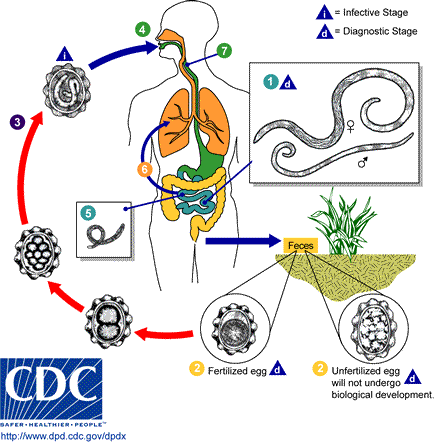The patient was a 9-year-old boy with recurrent abdominal pain sometimes associated with diarrhea and hematochezia. Extensive laboratory investigation was unremarkable and colonoscopy showed only mild erythema of the rectal mucosa.
The histologic evaluation of the colonic mucosa revealed a 2- to 3-µm-thick band of spirochetes that covered the luminal surface of the absorptive cells (Figure 1) and spared goblet cells (Figure 2). There was no significant inflammation in the lamina propria except for a mild increase in the number of eosinophils in places (Figure 1). The upper gastrointestinal tract showed no pathologic changes.
The patient was treated with erythromycin, 40 mg/kg/ day, for 10 days. With treatment, his abdominal pain resolved and rectal bleeding ceased.
Intestinal spirochetosis is characterized by heavy colonization of colonic mucosa by spirochetes. The presence of spirochetes in human bowel has been recognized since 1900, but it is still a matter of debate whether they are just commensal organisms or whether they represent a true colorectal disease.1
Human intestinal spirochetes comprise a group of bacteria of considerable heterogeneity, with many of them being classified as Borrelia eurygyrata, Brachyspirn aalborgi, or Serpulina pilosicoli. They are genetically unrelated to non-intestinal spirochetes, such as Treponema pallidum. A heavy infestation by intestinal spirochetes is described in both immunocompetent and immunocompromised hosts.
The mode of transmission remains unknown. Chronic fecal stasis might be implicated in spirochetal multiplication. In children, intestinal spirochetosis has been associated with ascariasis, enterobiasis, and Helicobacter pylori gastritis. Whether this is coincidental or reflects an oral route of infection is unclear.
Many authors regard these organisms as commensals, because small numbers of spirochetes are usually not associated with clinical symptoms. A heavy colonization, however, histologically appearing as a dense basophilic band along the entire colonic surface, may be associated with diarrhea, rectal bleeding, abdominal pain, purulent discharge, and an appendicitis-like picture. Symptoms can persist even after the eradication of spirochetes.
The spirochetes appear on hematoxylin-eosin-stained sections as a densely packed layer of organisms, which covers the luminal surface of the colonic absorptive epithelial cells but spares the goblet cells. The presence of intestinal spirochetes has been also documented within the crypt epithelial cells and lamina propria histiocytes as well as within Schwann cells. These findings reflect a potential for invasion and cell damage. The colonization is usually associated with no or only minimal inflammatory reaction within the lamina propria. The intestinal spirochetes are highlighted by periodic acid-Schiff, Giemsa, and Grocott as well as silver stains such as Warthin-Starry (Figure 3) and Dieterle.
A number of diagnostic tests based on genotypes have been developed for identification of Brachyspira species, including specific detection by polymerase chain reaction targeting 16S ribosomal DNA or 23S rDNA and fluorescent rRNA in situ hybridization with specific oligonucleotide probes directly from feces or paraffin-embedded tissue. There is no clear association between species and clinical or pathologic findings.2
References
1. Rotterdam H. Intestinal spirochetosis. In: Connor DH, Chandler FW, Schwartz DA, Manz HJ, Lack EE, eds. Pathology of Infectious Diseases. Stamford, Conn: Appleton & Lange; 1997:583-588.
2. Koteish A, Kannangai R, Abraham S, Torbenson M. Colonic spirochetosis in children and adults. Am J Clin Pathol. 2003;120:828-832.
Laurentia Nodit, MD; Maria Parizhskaya, MD
Accepted for publication March 10, 2004.
From the Department of Pathology, University of Pittsburgh Medical Center and Children's Hospital, Pittsburgh, Pa.
The authors have no relevant financial interest in the products or companies described in this article.
Reprints: Laurentia Nodit, MD, Department of Pathology, University of Pittsburgh Medical Center, A-610 Scaife Hall, 200 Lothrop St, Pittsburgh, PA 15213 (e-mail: noditl@upmc.edu).
Copyright College of American Pathologists Jul 2004
Provided by ProQuest Information and Learning Company. All rights Reserved



